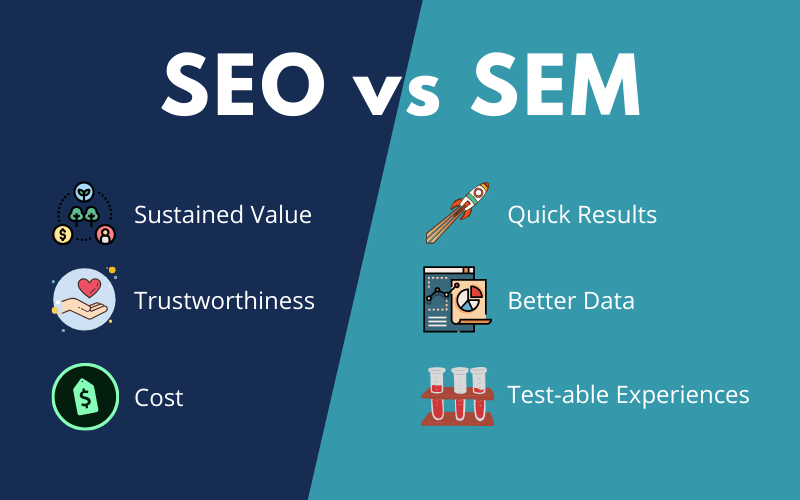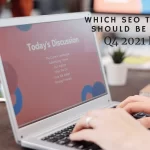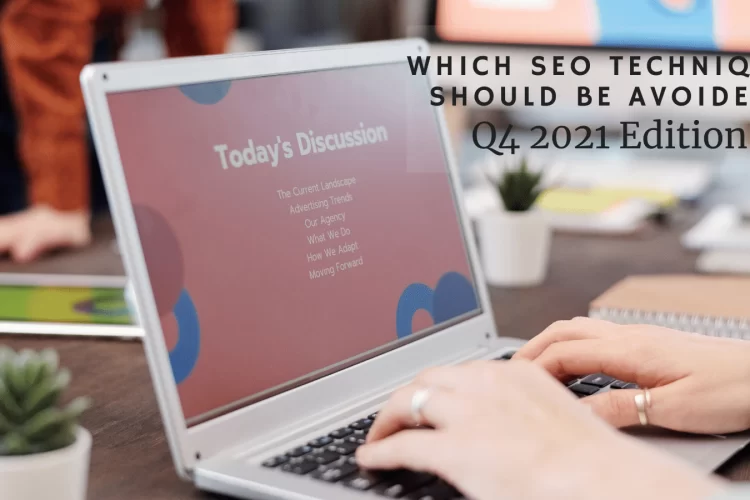
The main objective of planning your marketing budget is to deliver the best results for the lowest cost. When allocating funds to grow revenue through your website, you must consider both short-term gains and long-term profitability, which is why you should compare SEO with SEM.
The ideal combination can’t simply be one versus the other. The question is, what’s the best mix? What is the best way to cash in enough coins on SEM to hit your immediate goals without draining your funds and hindering future growth?
The most informed marketing decisions require an understanding of both SEO and SEM’s strengths and weaknesses.
The biggest difference is that SEO is an unpaid (or organic) marketing channel while SEM is a paid one. Both can be highly effective in reaching your target audience, improving brand awareness, and increasing web traffic.
The most efficient way to maximize your marketing results is to know when to employ SEO vs SEM.
What is search engine optimization (SEO)?
A Search Engine Optimization (SEO) campaign is a strategy that works to improve organic (non-paid) visibility in search engines to increase brand awareness. In addition to optimizing your website, a thoughtful off-site marketing campaign is also necessary.
Google places web pages on the web based on hundreds of different factors including the quality of the content, how well the page is built, how well it is linked, and many more factors. Google is ultimately trying to help searchers find the most relevant results to their queries.
To effectively compete in the organic search engine results pages (SERPs), it is necessary to implement some of the key SEO techniques described below.
On-Page SEO
Search engine optimization is the process of optimizing the elements of a single website in order to help search engines better understand what it’s about. This is done to ensure your content aligns with users’ expectations, including search intent, format, and comprehensiveness.
Basically, did you solve the user’s problem in the best way possible? On-page SEO also includes optimizing elements on the page, such as meta descriptions, title tags, headings, and image alt tags.
Off-Page SEO
It is common for domains with a large number of high-authority backlinks to appear higher in organic search results, and in fact backlinks are one of the top three factors that influence organic search results.
In a well crafted off-page SEO strategy, PR, social media, influencer collaborations, bylines, and standard outreach are used to build relevant backlinks. These links pass authority to the URLs they link to, as well as the domain as a whole.
Technical SEO
The technical components of SEO are concerned with improving the components of a website that are tech-related. These include CMS, coding, scripts, page load times and website speed, URL structure, XML sitemaps, robots, txt, schema (structured data), etc.
In addition to allowing search engine crawlers to discover, navigate, and index the right pages, technical SEO ensures that the pages adhere to Google’s Core Web Vital metrics for the best user experience.
Content marketing
For SEO, a high-quality, comprehensive content strategy is crucial, but what does it mean?
Basically, it means that everything you publish is expertly written, authoritative, and trustworthy. Google calls this E-A-T. Essentially, a well-researched keyword strategy and high-quality content that aligns with the user’s intent achieves higher rankings on Google.
Original visuals like videos, images, screenshots, memes, and infographics can also contribute to your SEO success. This is because these elements reach a larger audience and support link-building strategies.
What is search engine marketing (SEM)?
SEM (search engine marketing) refers to the use of paid search platforms to enhance visibility and increase targeted traffic to a website.
You can purchase pay-per-click (PPC) ads through Google Ads, Microsoft Ads (Bing ads), Yahoo, or other search engine advertising programs to have your brand appear in search results.
You can run cost-efficient ad campaigns, create enticing ad copy, and analyze data to determine the value and success of paid advertising by setting a budget, utilizing multiple ad formats, and utilizing multiple aspects of paid ads. In addition to optimizing campaign performance, it also involves adjusting various levers of a campaign to continually improve its performance.
SEO vs SEM differences
A key difference between SEO and SEM is that SEM purchases visibility, whereas SEO earns it. Therefore, SEM competes on budgets whereas SEO competes on quality and relevance. Here are some more factors that distinguish SEO from SEM.
Cost of SEO vs SEM
There are implementation costs associated with both SEO and SEM, and these effect ROI. For example, SEO is more expensive to implement due to the number of people involved, and it takes longer to achieve results, however, it produces a much higher ROI due to its compounding effects.
On the other hand, SEM has a quick ramp up, requires a lower lift, and generates revenue more quickly. As a result, if you compare the costs over a short period, SEM will likely win, but if you push it out to 24 months, SEO will come out ahead.
Here’s an example.
With an in-house SEO team, you will need to pay salaries, benefits, equipment, training, management, and an SEO technology stack. If you hire an SEO agency instead, you’ll pay a monthly fee and have a much quicker ramp up period to production.
When using PPC ads, you often have lower costs than through an in-house team or agency, but you still have the cost per click of the ads, which can be in the millions of dollars per month, depending on your market and budget, as well as the agency you use.
Many companies pay exponentially more for ad clicks than for SEO monthly costs, even though SEO can lead to cost efficiencies and greater business performance. Read our post about the upside-down approach that many brands take to SEO versus SEM budgets to learn more.
Time it takes to get results
The difference in time between SEO vs SEM is crucial when comparing the two. SEM can deliver traffic almost immediately; by comparison, SEO can take months to generate meaningful traffic.
Due to the differences, you should be strategic in how you prioritize your approach. If you want to quickly drive traffic to a temporary website for a seasonal event, SEM is your best option. However, if you want to create an evergreen content hub centered on a key phrase that has compounding value over time? You need SEO.




